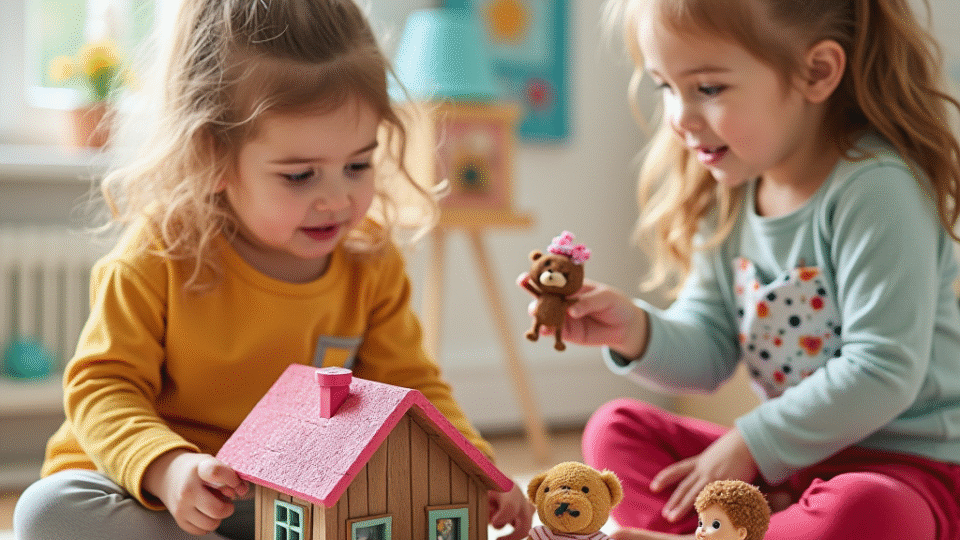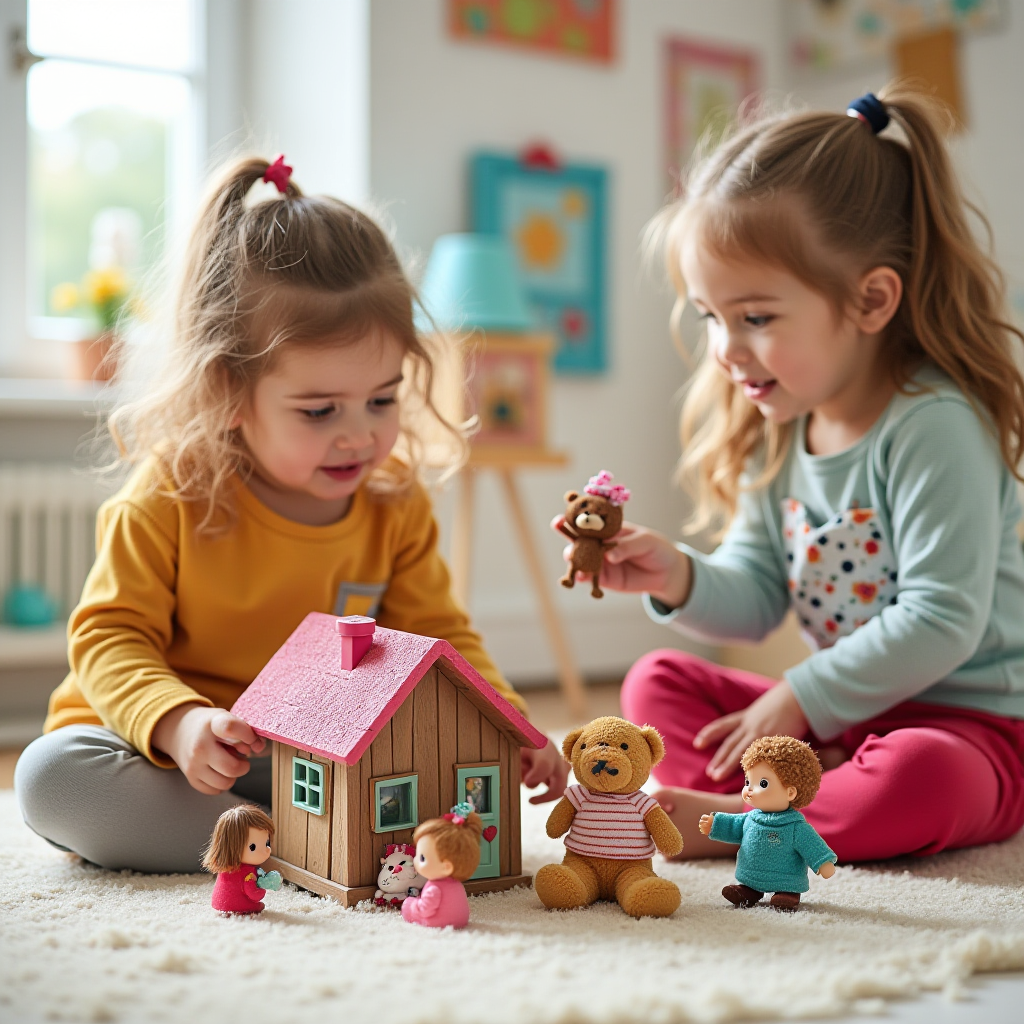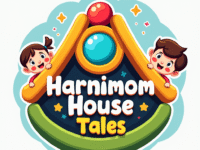
Imaginative Play at Age 2: How Pretend Play Boosts Toddler Growth
At age two, toddlers are stepping into the magical world of imagination. They may pretend a block is a car, a spoon is a microphone, or that they’re cooking dinner just like you. This kind of imaginative play is more than just adorable—it’s an essential part of learning and growing.
As a parent, I’ve seen how pretend play toys keep little ones busy while secretly teaching them problem-solving, empathy, and communication. In this blog, let’s explore why imaginative play matters at age two, the best toys to encourage it, and how you can support your toddler’s creativity at home.
Why Imaginative Play Matters at Age 2

Two-year-olds are at a stage where they begin copying what they see in daily life. Pretend play allows them to try out new roles, practice conversations, and make sense of the world around them.
Here’s what imaginative play does for toddlers:
- Boosts language development – Acting out stories encourages toddlers to use new words and phrases.
- Builds empathy – Pretending to be a doctor or parent helps them see life from someone else’s perspective.
- Encourages problem-solving – What happens if the “soup” spills or the “car” won’t start? Pretend play offers creative challenges.
- Improves social skills – Toddlers learn to take turns, share roles, and play together.
I talked about this more generally in my post on Top Toddler Toys for 2-Year-Olds, where pretend play came up as one of the most important categories.
The Best Pretend Play Toys for 2-Year-Olds
The right toys can spark a toddler’s imagination and encourage long hours of creative play. Here are some favorites:
1. Play Kitchens
Mini stoves, pots, and pretend food are classics for a reason. Toddlers love copying what they see in the kitchen. These sets encourage role play and even basic sorting (like grouping fruits and vegetables).
For parents looking for Perfect Birthday Gifts for Toddlers, play kitchens are often a hit because they’re long-lasting and versatile.
2. Doctor and Vet Kits
With toy stethoscopes, bandages, and check-up tools, toddlers can take care of stuffed animals, dolls, or even family members. This type of play builds empathy and reduces fear of real doctor visits.
I’ll be sharing more on pretend kits in my future blog on Stocking Stuffers for Toddlers, since many mini sets fit perfectly in that category.
3. Tool Sets
Toddlers love fixing things. Pretend hammers, screwdrivers, and saws let them copy what they see adults do around the house. Tool sets encourage problem-solving and hand-eye coordination.
4. Dress-Up Costumes
Even simple costumes like a firefighter hat, animal ears, or a superhero cape can lead to hours of pretend adventures. Dress-up play lets toddlers explore roles and dream big.
For more open-ended play suggestions, you might also enjoy my post on Educational Toys for 2-Year-Olds, which connects learning with fun.
5. Dollhouses and Figures
Small dolls, animals, or action figures give toddlers a stage for storytelling. They can create families, communities, or imaginary worlds—building both narrative skills and creativity.
6. Vehicles and Pretend Cars
From cardboard box “cars” to toy firetrucks, vehicles help toddlers imagine themselves in different roles like drivers, pilots, or rescue workers.
How Parents Can Support Imaginative Play
Pretend play works best when parents encourage it without taking over. Here are a few tips from my own parenting experience:
- Join in sometimes: Sit down and be the “customer” at your toddler’s pretend restaurant.
- Provide simple props: A cardboard box can become a spaceship, house, or boat.
- Rotate toys: Keep pretend play fresh by swapping in and out different sets.
- Let them lead: Follow your child’s storyline, even if it makes no sense to you.
- Encourage storytelling: Ask open-ended questions like, “What happens next?”
I’ve also found that combining pretend play with outdoor fun, like in my upcoming post on Outdoor Toys for 2-Year-Olds, makes playtime even richer. A sandbox, for instance, can quickly become a pretend bakery or construction site.
Everyday Pretend Play Ideas Without Fancy Toys
You don’t need expensive sets for imaginative play. Some of the best pretend games happen with items you already have:
- Laundry day: Let your toddler “fold” or pretend to wash doll clothes.
- Cooking show: Give them safe utensils and let them “cook” with dry pasta or pretend ingredients.
- Picnic time: Spread a blanket and have a pretend snack with stuffed animals.
- Travel adventure: Line up chairs and pretend you’re on a bus, train, or airplane.
- Store shopping: Set up canned goods or boxes for your child to “buy” with play money.
These small moments build creativity and give toddlers the chance to explore big ideas in a safe, playful way.
Wrapping Up: The Magic of Pretend Play
At age two, imaginative play is a window into your toddler’s mind. Whether they’re pretending to be a chef, doctor, or superhero, they’re learning valuable lessons in communication, problem-solving, and empathy.
As parents, our role is to encourage, provide props, and enjoy the creativity that unfolds.
If you’re building a toy collection, don’t forget to check out my guides on Best Toy for 2-Year-Olds in 2025 and Top Toddler Toys for 2-Year-Olds for a bigger picture of what works at this age. And if you’re looking ahead, you’ll also love my blog on Perfect Birthday Gifts for Toddlers.
Imaginative play is not just fun—it’s the foundation of learning.












